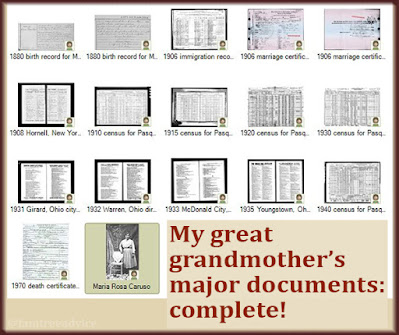You may not trust someone else's family tree, but you can stand behind your facts. Right?
Every now and then you're going to find a very intriguing hint. From what you can see, it looks like it's your family. It's got a lot of names you're missing. You get a little excited.
Then you realize this potential jackpot of a family tree has no sources. No documents. They haven't even capitalized all the proper names. This is not a carefully crafted family tree.
Excitement over.
This sad story should motivate you to fortify your family tree. Make your tree be the exciting find that keeps on giving.
Here's how other genealogists are going to know your family tree is the real deal. It's extremely well-crafted. These 3 things will prove to anybody that your family tree is correct.
 |
| If your tree has this much solid evidence, who could doubt you? |
1. Official Documents
Gather and add to your tree as many government-issued documents as possible. Whatever country your ancestor is from, their government will have created certified-reliable documents, including:
- birth records
- census forms
- marriage records
- death records
- citizenship papers
- military records
- passports
Other official records don't come from a government:
- ship manifests
- church baptism records
- school yearbooks
- city directories
- newspapers
The last 3 might be the most likely to have errors, but they can provide supporting evidence.
What aren't official are stories passed down through the generations, family bibles, and my brother's college project to write about our family history. (Sorry, Jay.) You've got to strive for those official documents.
2. Official Sources
Lots of times you can't find an official document or an image of a document to support a fact. A good example is the "last place of residence" listed on the Social Security Death Index (SSDI). That's a fact you want to put in your family tree, but you haven't got any document.
That's when it's important to record the source of the fact. You can find details about the source wherever you're viewing it. If it's a website like Ancestry.com, there is a detailed description of the source. If you're in the archives looking at microfilm, the film's box or the beginning of the reel will hold some information.
What's most important is to capture the accurate name and origin of the source. "U.S., Social Security Death Index, 1935-2014; Social Security Administration. Social Security Death Index, Master File."
Then capture something more specific to your ancestor. My late step-grandmother's SSDI listing has an additional source citation: "Number: 081-07-1687; Issue State: New York; Issue Date: Before 1951".
If someone's tree has that level of documentation, are you seriously going to doubt them?
3. Supporting Sources
I spend tons of time going through Italian civil records, piecing together my ancestors' families. I love it when an ancestor's official birth record has annotations in the column. Those notes may include their marriage date and place, spouse's name, and their death date.
That's official and corroborating evidence.
Do your best to gather all a person's documents, and you'll find that you have supporting sources, too. A mother's maiden name on your ancestor's death record is not reliable. But if it matches the name on your ancestor's birth and marriage records, it is very reliable.
Make Your Tree Provable
If you've been reading this and thinking, "I'm not sure I can prove my tree is correct," you've got some work to do:
- Start replacing your sketchier sources with more official ones. Some of my sources are "my cousin told me." That might be fine if your cousin told you "this person's nickname was Baldy." But if the facts are important, track down an official source or an official document.
- Try to get as many documents as you can for your people. This way you'll have supporting evidence that says, "Yes, he was born on this date in this place. It says so here, here and here." Find each major, available document for the people in your tree and close the book on them.
- Be consistent in how you record dates and names. Your online tree should show each person's full name. If you're not using software that automatically formats your dates, take the time to type them in the same style.
Hopefully you're thinking your tree is in pretty good shape. If so, keep these ideas in the back of your mind. The next time you're reviewing someone in your tree, think about how you can make their facts more bulletproof.
Make your family tree be exactly the type of tree you'd love to find as a hint!










